Abstract
As of 2021, the maximum harvest yield of rice farming in Japan nationwide is 7.56 Mt, the maximum cultivated area is 1.4 Mha, and the maximum yield per 10 a is 626 kg (Yamagata Prefecture). Past trends show that rice production efficiency has improved and harvest yields are on the rise. On the other hand, although the area under cultivation has shown a slight tendency to decrease, the introduction of efficient production techniques has led to an improvement in yields per 10 ares. High yields have been achieved, especially in some areas such as Yamagata Prefecture. This trend is interpreted as the result of efforts and technological innovations towards sustainable agricultural production. In the future, rice production will likely require efforts that emphasize both efficiency and sustainability.
Rice yield (main data).
Taking into account data from 1883 to 2021, Japan’s rice harvest was the highest ever at 14.3Mt in 1967. Yields have since declined and are now at about 53% of their peak. Behind this trend lie changes in agricultural structure, the advancement of urbanization, and the diversification of dietary habits. In addition, improvements in agricultural technology and production efficiency have made it possible to harvest more from a smaller area. As a result, although harvest volumes are lower than at their peak, efficient rice production is being carried out while maintaining food self-sufficiency. In the future, the challenge will be to ensure sustainable rice production, while also taking into account factors such as population decline and climate change.
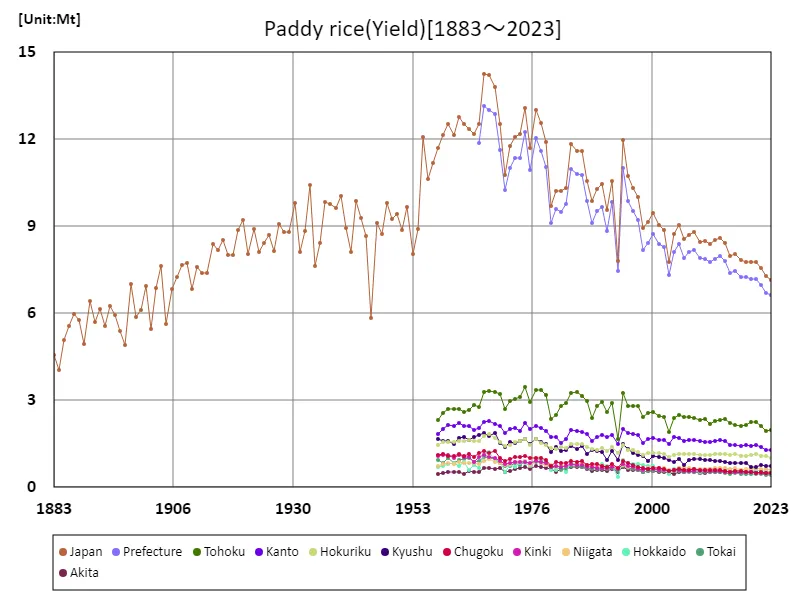

The maximum is 14.3Mt[1967] of Japan, and the current value is about 50.3%
Rice harvest volume (by prefecture).
In terms of Japan’s rice harvest, the latest data for 2021 shows that Niigata Prefecture recorded the highest overall yield of 620kt, which is currently the highest. This trend is the result of Niigata Prefecture having been a major rice producing area for many years, and the advancement of agricultural technology and the establishment of efficient production systems. Rice production is also actively carried out in other regions, with each region having different characteristics and production volumes. On the other hand, despite facing challenges such as a declining population and a shrinking agricultural labor force, Japan’s rice production has remained stable thanks to technological innovation and the promotion of sustainable agriculture. In the future, even as we face the effects of climate change and environmental issues, further technological innovation and the development of sustainable agricultural policies will be required to ensure a stable supply of high-quality rice.
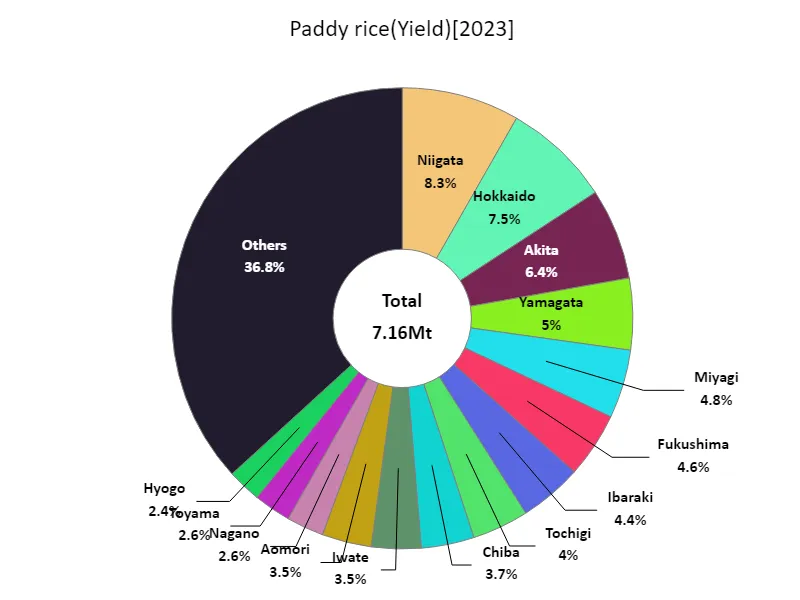

The maximum is 592kt of Niigata, the average is 152kt, and the total is 7.16Mt
Area cultivated with rice (main data).
Taking into account data from 1883 to 2021, Japan’s rice cultivation area was at an all-time high of 3.17 Mha nationwide in 1969. Since then, the area under cultivation has decreased and is currently at about 44.2% of its peak. This trend is influenced by changes in agricultural structure, urbanization, and the diversification of diets. In addition, improvements in agricultural productivity mean that the same yield can be achieved on a smaller area. Efficient agricultural management is required, especially as the agricultural workforce is declining and aging. On the other hand, there are some regions where the tradition of wet rice cultivation is deeply rooted and the area cultivated there is relatively stable. In the future, promoting sustainable rice cultivation will be important from the perspective of environmental conservation and food security.
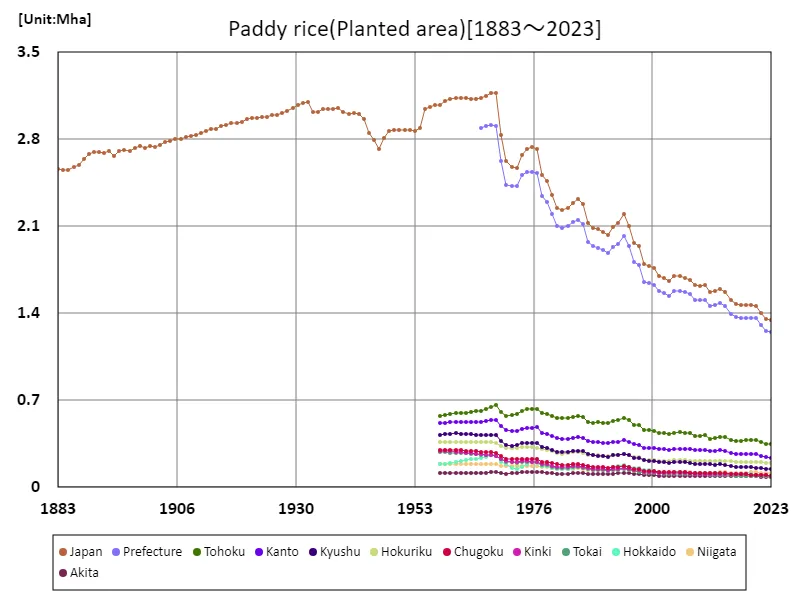

The maximum is 3.17Mha[1969] of Japan, and the current value is about 42.4%
Area cultivated with rice (by prefecture).
According to the latest data for 2021, Niigata Prefecture recorded the largest area of rice cultivation in Japan at 117kha, which is currently the largest area. This trend reflects the fact that Niigata Prefecture is a major rice-producing area, and that the region’s climatic conditions and advances in agricultural technology have made large-scale rice cultivation possible. On the other hand, rice cultivation is also carried out in other regions, with characteristics and production volumes differing from region to region. In addition, due to changes in agricultural structure and the progress of urbanization, there is a tendency for cultivated area to decrease in some regions. However, rice is Japan’s staple food, and efficient cultivation is required from the perspective of food security. In the future, it will be important to introduce appropriate cultivation techniques and develop agricultural policies that take into account environmental protection and sustainability.
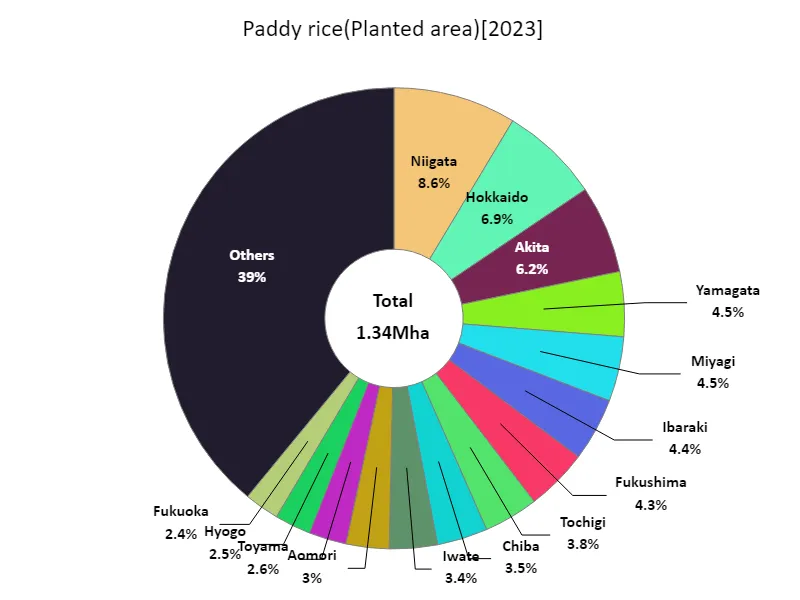

The maximum is 116kha of Niigata, the average is 28.6kha, and the total is 1.34Mha
Rice yield per 10a (by prefecture).
According to the latest data for 2021, Yamagata Prefecture recorded the highest yield per 10a of rice in Japan at 626kg, with the average being 512kg, and the total being 24.1t. This trend is due to high yields in some areas, such as Yamagata Prefecture, pushing up the overall average. In Japan’s rice production, yields per 10 ares have been increasing thanks to advances in agricultural technology and improved varieties. On the other hand, yields vary depending on the region due to differences in climate and soil conditions. Furthermore, from the perspective of sustainable agricultural production, it is necessary to cultivate high-quality crops while maintaining high yields. In the future, it will be important to make efforts to maintain efficient rice cultivation and ensure food security, even in the face of the effects of climate change and natural disasters.
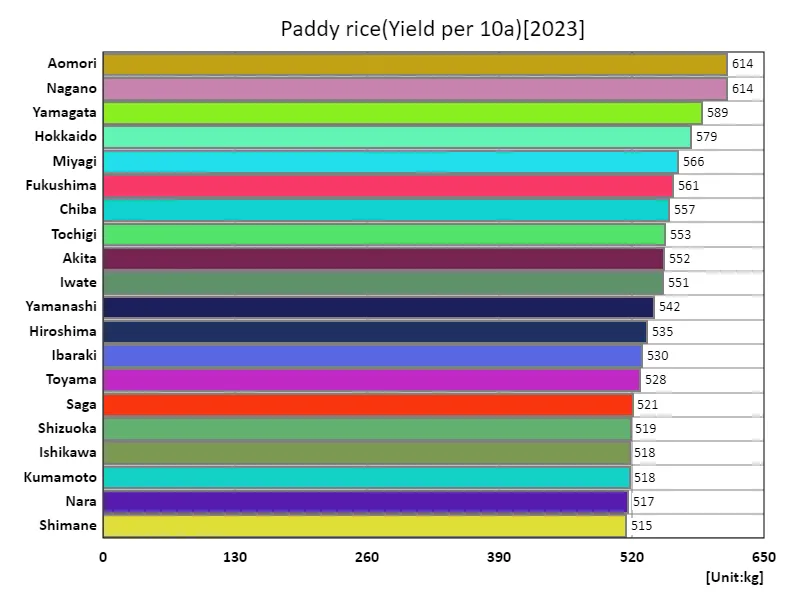

The maximum is 614kg of Aomori, the average is 511kg, and the total is 24t



Comments